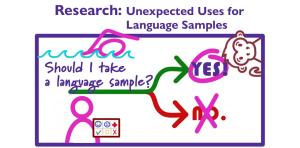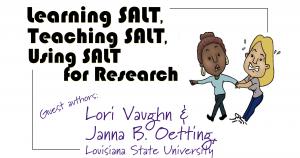-
Research: Unexpected Uses for Language Samples
Dec 01 20210From toddlers with cochlear implants to adults with primary progressive aphasia (and everything in between), SALT has been part of researching people’s spoken language. Oh, and apes’ too! One of my great joys is consulting with researchers from Communication Sciences and Disorders, Psychology, Linguistics, Neuroscience, Ed Psych and more and finding out their research interests to determine how...
-
SALT Research: the Rectangular Data File
Oct 21 2021“The RDF tool has helped my research immensely. I can quickly generate pilot data from a dozen samples or efficiently compile data from hundreds of samples at the end of the project. The tool exports data in spreadsheets compatible with the main software tools that I use, so I never have to worry about compatibility or converting to different formats.” John Heilmann, Ph.D., Univer...
-
Why do we mark some bound morphemes and not others?
Jan 28 2021The SALT reference databases use a very specific set of conventions for marking bound morphemes. Our protocols do not represent the only way to mark morphemes but if you want to compare your sample against our databases, it is important for you to use these same conventions. If you aren’t interested in the nuts and bolts, just skip down to the “Summary” section. It’s the most condensed version ...
-
Those were the Good Ol’ Days: Historical Trends in Language Sampling and Analysis
Jan 27 2021Rhea Paul, PhD, CCC-SLP Sacred Heart University Rhea received her Ph.D. from the University of Wisconsin-Madison in 1981, and has taught language development and disorders in children for over 30 years. You probably know her as the author of the quintessential textbook: Language Disorders from Infancy Through Adolescence. Her latest projects include her podcast, Let’s Talk About Super Special K...
-
Why Voice Recognition Doesn’t Work for Transcription
Jan 26 2021You mean, I can’t just record the language sample right into SALT? When talking with people new to SALT I frequently hear, “Oh, I have to transcribe the sample? Can’t I just record into SALT?” There is typically a look of disappointment when I reply that the speech recognition software available to us today just isn’t accurate enough for our purposes. The goal of LSA is to document functional,...
-
Language, Criminal Justice, and the Role of SLPs: Continuing the Conversation
May 21 2020In the first installment of this article we discussed the case of Brendan Dassey, a young man with language disorder who was tried and convicted of murder despite profoundly problematic police interrogation methods. Brendan was a minor at the time. Brendan’s case was both tragic and fascinating. It was even the focus of a Netflix documentary, Making a Murderer. More importantly, it raises big q...
-
Language, Criminal Justice, and the role for SLPs: A conversation about "Making a Murderer"
Feb 10 2020This article is based on a telephone conversation between Sally Miles, Ph.D., CCC-SLP and Karen Andriacchi M.S., CCC-SLP. The conversation was a follow-up to the language sample transcription [by SALT Services] and the analysis [by Sally using SALT software] of the Brendan Dassey interrogations made famous by the Netflix documentary, “Making A Murderer”. The first half of the interview (today’s...
-
Learning SALT, Teaching SALT, Using SALT for Research
Jan 15 2019Guest authors: Lori Vaughn & Janna B. Oetting, Louisiana State University Janna: Welcome to the Ph.D. program Lori. You need to learn SALT. Lori: My head is about to explode from everything in this Ph.D. program! Janna: You will find that you can’t live without SALT. Lori: They tried to teach me SALT in graduate school. Janna: Now is the perfect time to master SALT. As part of your f...
-
Opportunities to Combine LENA Recording Technology and SALT
Nov 16 2018Dr. Kimbrough Oller Professor and Plough Chair of Excellence The University of Memphis School of Communication Sciences and Disorders The technology produced by the LENA Foundation for all-day recording in the home with a battery-powered device worn in infants' and children's clothing has added a major new method to the study of the acquisition of language. There has been a great deal of emph...









